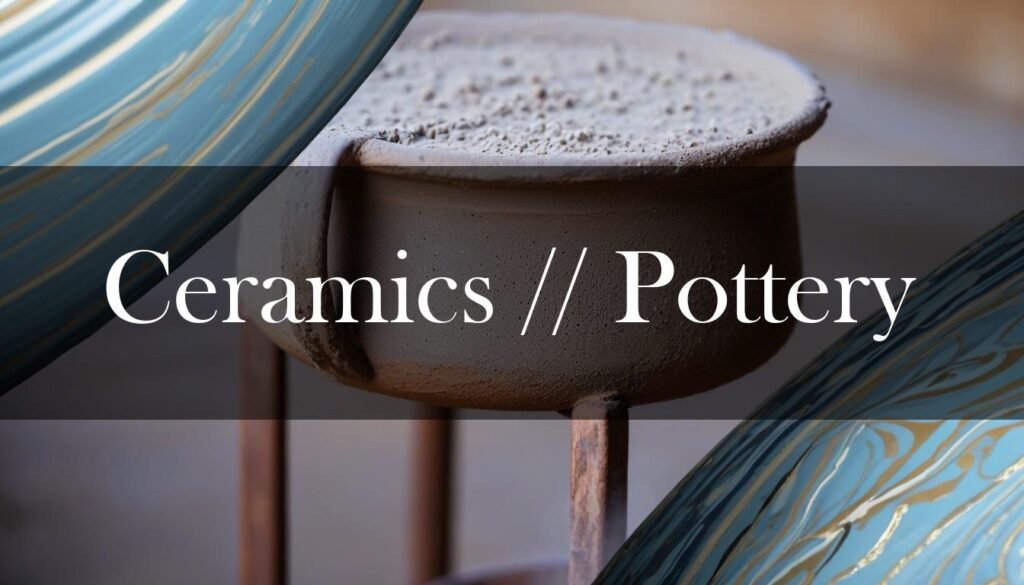Have you ever wondered what your favorite mug or decorative plate is actually made of? The world of ceramics is fascinating, and understanding what goes into these creations helps us appreciate them even more. At its heart, ceramics are inorganic, non-metallic materials, primarily composed of metal oxides, nitrides, or carbides. The magic lies in how these components come together through ionic and covalent bonds, giving ceramics their signature hardness, brittleness, and high melting points. (More information can be found here)
One of the most common ingredients in ceramics is kaolinite, also known as kaolin or china clay (Al₂Si₂O₅(OH)₄). It’s the star of the show, especially in porcelain, thanks to its purity and high melting point. (More information is available on this website) Then there’s ball clay, a mix of kaolinite, quartz, and mica, which adds plasticity, making the clay easier to work with, though it can cause excessive shrinkage if used alone. Feldspar, containing alkaline oxides like sodium, potassium, and calcium, acts as a flux, lowering the melting point and helping the mixture vitrify. (You can read more about the ingredients here) Bone ash, derived from calcined animal bones and mainly composed of hydroxyapatite (Ca₅(OH)(PO₄)₃), can make up to 50% of bone china, giving it that lovely translucency and heat resistance. (More information on bone ash can be found here) And let’s not forget silica (quartz), or silicon dioxide (SiO₂), which contributes to the hardness and thermal stability of ceramics. (More about silicon dioxide)
The specific ingredients used in ceramics can vary depending on the desired properties of the final product, but these are some of the key components that you’ll often find in ceramic recipes.
Now, let’s talk about different types of pottery and what makes each one unique. Earthenware, often fired at lower temperatures (around 800°C to 1,150°C), is porous and frequently used for decorative pieces, showcasing a warm terracotta color. (More on Earthenware) Because it is made from clay that is fired at relatively low temperatures, typically below 1,200°C (2,192°F), it remains porous and non-vitreous, meaning it will absorb water unless glazed. (Learn more about Earthenware) Stoneware, on the other hand, is fired at higher temperatures (around 1,200°C to 1,300°C), becoming non-porous and incredibly durable, perfect for your everyday dinnerware. (More info on Stoneware) Stoneware is a type of ceramic that is fired at high temperatures, typically between 1,100°C and 1,300°C, resulting in a dense, durable, and non-porous material, which is why it’s so strong. (More about Stoneware) Porcelain, known for its delicate whiteness and translucency, is crafted from kaolin, feldspar, and quartz and fired at even higher temperatures, between 1,200°C and 1,400°C. (More about porcelain) Porcelain is a ceramic material made by firing a blend of raw materials like kaolin, feldspar, and quartz at high temperatures, resulting in a vitrified, non-porous body. (More information on porcelain) And then there’s bone china, a type of porcelain that includes bone ash in its recipe (about 50%), giving it exceptional strength and translucency. (Read about Bone China here)
It’s interesting to note how each type of pottery has its own distinct characteristics based on its composition and firing temperature.
These differences make each one suitable for different purposes, from decorative items to functional tableware.
The firing temperatures play a huge role in the final product with Earthenware typically fired between 1,650°F and 1,950°F (900°C to 1,100°C). (More about firing temperatures) Stoneware is fired at higher temperatures, typically between 2,010°F and 2,232°F (1,100°C to 1,220°C). (Firing temperatures and more) and Porcelain requires the highest firing temperatures, often between 2,400°F and 2,552°F (1,315°C to 1,400°C). (Read about firing pottery here)
The higher the firing temperature, the denser and less porous the ceramic material becomes.
The properties of ceramics are intricately linked to their chemical bonds and crystal structures. Ionic bonds, which form between metals and non-metals, and covalent bonds, which form between non-metals, are what give ceramics their hardness and brittleness. For example, the ionic bonding in magnesium oxide (MgO) creates a stable and refractory material. (More information on chemical properties) Understanding the composition and bonding in ceramics is not just about the technicalities; it’s about appreciating the artistry and science that come together to create these beautiful and functional objects.
Hopefully, this has provided a clearer understanding of the world of ceramics, from the materials they are made from, to the temperatures they require to be fired. You now have a greater understanding of what it takes to make pottery!





